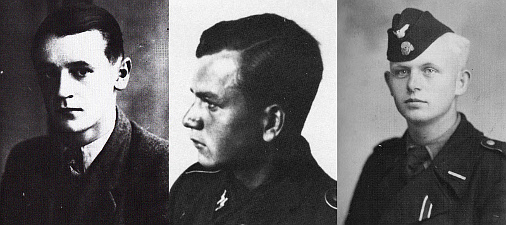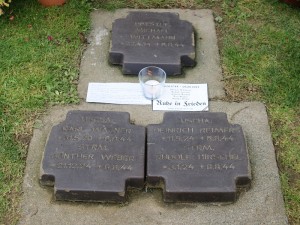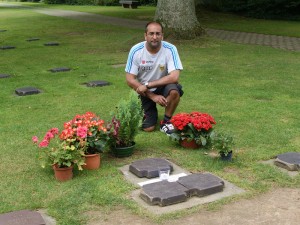Allein! wieder allein! Einsam wie immer.
Vorüber rauscht die Jugendzeit in langer, banger Einsamkeit.
Mein Herz ist schwer und trüb mein Sinn, Ich sitz’ im gold’nen Käfig drin.Es steht ein Soldat am Wolgastrand, hält Wache für sein Vaterland.
In dunkler Nacht allein und fern, es leuchtet ihm kein Mond, kein Stern.
Regungslos die Steppe schweigt, eine Träne ihm ins Auge steigt:
Und er fühlt, wie’s im Herzen frißt und nagt,
wenn ein Mensch verlassen ist, und er klagt, und er fragt:
Hast du dort oben vergessen auf mich? Es sehnt doch mein Herz auch nach Liebe sich.
Du hast im Himmel viel Engel bei dir! Schick doch einen davon auch zu mir.Das Wolgalied, the song of the Ostfront.
In the spring of 1983, almost thirty-nine years after their death in the field outside Gaumesnil, Michael Wittmann and his crew were finally laid to rest at the German military cemetery at La Cambe in Normandy, located on the road NR 13 between Isigny-sur-Mer and Bayeux. The grave, which is adorned with the names of Wittmann and all four crewmembers of Tiger 007 – driver Heinrich Reimers, gunner Karl Wagner, loader Günther Weber and bow machine-gunner/radio operator Rudolf Hirschel – is the 120th of row 3, block 47.

SS-Hauptsturmführer Michael Wittmann would leave behind his widow Hildegard, and a legacy that very few would match. In an astonishing career, he had destroyed a total of 138 enemy tanks and 132 anti-tank guns and other heavy artillery pieces, not to say hundreds of other light vehicles. It must be remembered here that his initial tank kills were achieved while he was commander of a Sturmgeschütz III; one cannot begin to imagine what his final score might have been had the Tiger I been developed earlier during the war.
At the time of his death, Michael Wittmann was a significant but at the same time yet another casualty of a conflict that was fast approaching its end. Within a year of his death in Normandy, the once all-powerful Reich had collapsed – with its Führer taking his own life in his Bunker in Berlin with the remaining men of the Leibstandarte fighting fiercely for every remaining inch of ground. The human cost of the six-year conflict was immeasurable: among the grieving millions across the continent was Hildegard Wittmann, now a nineteen year old widow.
In the space of less than six months Frau Wittmann’s life had been turned on its head. She would later remarry and continue to live a quiet life, maintaining a dignified silence about both the war and her first husband.
The same dignified silence was shared by Balthasar Woll, Wittmann’s friend, best man, comrade-in-arms and gunner during the long and hard campaigns in Russia. Having been away from the front undergoing medical treatment at the time of Michael Wittmann’s death, Woll would escape the fate suffered by his commander and comrades. Unwilling to make capital out of his association with Wittmann or even in his own right as a Knight’s Cross winner, Balthasar “Bobby” Woll survived both the war and the upheaval of the immediate postwar period, passing away in 1996 at the age of seventy-three.
The Cemetery
Located just off the Route Nationale (RN) 13 between the towns of Isigny-sur-Mer and Bayeux, the Soldaltenfriedhof in La Cambe is easy to find. You can find out more about visiting the cemetery in the Places to See section, which includes directions and maps.
Located next to the cemetery is an extensive information centre which also houses a small museum and a permanent exhibition dedicated to peace. The information centre is also equipped with an interactive computer system that allows the user to locate any specific grave within the cemetery.
By far the largest of the Second World War cemeteries in Normandy with some 21,500 graves, the Soldatenfriedhof at La Cambe by its very expansiveness provides a striking illustration of the sheer extent of the losses suffered by the Germans, particularly the Panzer divisions of the Waffen-SS, during the Normandy campaign. The central stone memorial monument, located on a small knoll, adds to the sombre mood, as does viewing the hundreds of rows of grey stones from the viewing platform.
Michael Wittmann’s grave, which is one of three stones adorned with the names of the Panzer commander and all four crew members of Tiger 007 – driver Heinrich Reimers, gunner Karl Wagner, loader Günther Weber and bow machine-gunner/radio operator Rudolf Hirschel – is the 120th of row 3, block 47.
“I can scarcely put into words the love and respect I have felt for him. His strict but correct leadership made soldiers of us, soldiers ready to walk through fire with him at any time. We could take all our problems to him; he had helpful advice, or if appropriate a counseling word, for everyone. He knew all of his ‘old’ men and appreciated their daily concerns. In action he always drove in the lead, a shining example. If a tank failed to return his greatest concern was his men. Near him we were sure of refuge and salvation if something happened to us. I never loved an officer more than I did our Michael Wittmann.”
Sturmmann Günther Braubach, a member of Wittmann’s platoon 13, November 1943.
[youtube=http://www.youtube.com/watch?v=BPu3qjQyPqs&w=640&h=360]
My visit to La Cambe on 8th August 2014, the seventieth anniversary of his and his crew’s death on the battlefield in Normandy near St. Aignan de Crasmenil
Roll call
SS-Hauptsturmführer Michael WITTMANN
 22.04.1914 Vogelthal, Landkreis Beilngries, Oberpfalz, Bayern.
22.04.1914 Vogelthal, Landkreis Beilngries, Oberpfalz, Bayern.
 08.08.1944 near St. Aignan-de-Cramesnil, Basse-Normandie, Calvados, France.
08.08.1944 near St. Aignan-de-Cramesnil, Basse-Normandie, Calvados, France.
SS-Unterscharführer Heinrich REIMERS
 11.05.1924 Schnepke, Grafschaft Hoya, Provinz Hannover.
11.05.1924 Schnepke, Grafschaft Hoya, Provinz Hannover.
 08.08.1944 near St. Aignan-de-Cramesnil, Basse-Normandie, Calvados, France.
08.08.1944 near St. Aignan-de-Cramesnil, Basse-Normandie, Calvados, France.
SS-Unterscharführer Karl WAGNER
 31.05.1920 Eppisburg, Landkreis Dillingen a. d. Donau, Schwaben, Bayern.
31.05.1920 Eppisburg, Landkreis Dillingen a. d. Donau, Schwaben, Bayern.
 08.08.1944 near St. Aignan-de-Cramesnil, Basse-Normandie, Calvados, France.
08.08.1944 near St. Aignan-de-Cramesnil, Basse-Normandie, Calvados, France.
SS-Sturmmann Rudolf HIRSCHEL
 03.01.1924 Gleiwitz (now Gliwice), Provinz Schlesien.
03.01.1924 Gleiwitz (now Gliwice), Provinz Schlesien.
 08.08.1944 near St. Aignan-de-Cramesnil, Basse-Normandie, Calvados, France.
08.08.1944 near St. Aignan-de-Cramesnil, Basse-Normandie, Calvados, France.
SS-Sturmmann Günther WEBER
 24.12.1924 Sprockhövel, Landkreis Ennepe-Ruhr-Kreis, Provinz Westfalen.
24.12.1924 Sprockhövel, Landkreis Ennepe-Ruhr-Kreis, Provinz Westfalen.
 08.08.1944 near St. Aignan-de-Cramesnil, Basse-Normandie, Calvados, France.
08.08.1944 near St. Aignan-de-Cramesnil, Basse-Normandie, Calvados, France.
 |
 |
The cemetery at La Cambe, like the many other German war memorials around the world, is maintained by the German War Graves Commission (Volksbund Deutsche Kreigsgräberfürsorge, VDK), an organisation financed by some 1.3 million members and donors. From the UK, cheques can be sent to:
Volksbund Deutsche Kriegsgräberfürsorge e.V.
Werner-Hilpert-Straße 2
34112 Kassel
Germany
